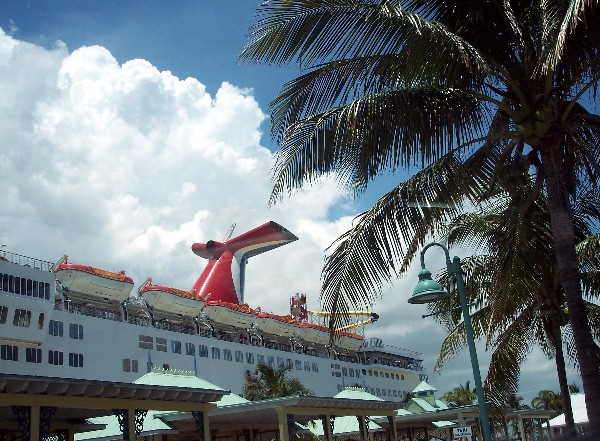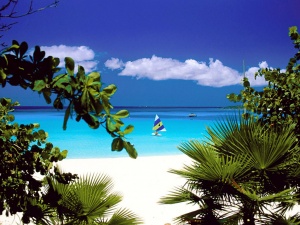This post may contain affiliate links. We may earn money or products from the highlighted keywords or companies or banners mentioned in this post.
March 2, 2015 By: Susan Young
 |
| Carnival Cruise Lines and Costa Cruises are showing economic recovery from the difficult events of the past few years, says analyst Robin Farley. // Photo by Susan J. Young |
Robin Farley, cruise industry analyst, UBS Investment Research, visited recently with top cruise line leaders in Miami. What did she learn? Overall, she sees good earnings potential for the lines ahead.
She said Royal Caribbean Cruises Ltd. (RCL) and Norwegian Cruise Line Holdings (NCHL) have both “been more vocal regarding their goal to double earnings by 2017.”
While Carnival Corporation (CCL) may not have communicated that message as succinctly, it too is providing guidance for a doubling of EPS (earning per share) and to double-digit returns, Farley says, but just a bit more indirectly.
Farley says in three to four years Carnival Corp. might also post a double-digit return on investment. She said UBS Investment Group’s 2017 earning per share estimate for Carnival is $4.38; that's double what CCL achieved in 2014.
With Carnival Corp.’s yields still 10 percent below their peak (and Carnival Cruise Lines and Costa Cruises brands comprising two-thirds of that lag), the company may be headed for above-industry yield growth, driven by recovery from difficult events of the past few years.
The Costa brand has recovered half the yield lost after Costa Concordia while the Carnival brand has had a single-digit yield increase in the fourth quarter. So the two brands are performing better and headed in the right direction.
Farley said CCL’s best performing brand is Aida, the German brand.
This Year’s Wave
“By all accounts, [it’s] a better Wave Season than last year, with a lot of promotions, but rates [are] higher than last year,” Farley said. The annual top selling period kicked off a bit earlier, though, in December 2014. Farley says that resulted in a slower booking pace in early January.
 In contrast, sales from late January through the present are now improving. NCLH had a 20 percent volume in the last four weeks. Farley also noted that NCLH’s bookings for 2016 are more than double the amount of bookings they had a year ago for 2015.
In contrast, sales from late January through the present are now improving. NCLH had a 20 percent volume in the last four weeks. Farley also noted that NCLH’s bookings for 2016 are more than double the amount of bookings they had a year ago for 2015.
“Our sense is that CCL and RCL are also seeing Wave pick-up,” she said. Increased television advertising and package pricing are driving more effective yields.
RCL wouldn’t update its Wave commentary beyond what it said on its January 29 earnings call — during which it told analysts that the prior two weeks in January were the best two weeks for bookings in the company's history.
Another reason cited for improved RCL, NCHL and CCL results is that there are no MSC Cruises promotions for the Caribbean after April. Last year, MSC had an aggressive pricing stance with fares as low as $199 per person for a week-long cruise.
In addition, “the cruise lines have spent significantly more on TV advertising this year, which seems to be a more effective driver of demand than simply to lower prices,” Farley notes. For 2015, many cruise lines are gravitating to offers with added value propositions including onboard credit; that's typically less costly for cruise lines than slashing fares.
China and Cuba
“RCL’s two existing ships in China are already its most profitable ones,” says Farley. With Quantum of the Seas beginning service in China in June, “RCL already has good visibility on where prices will come in,” she added.
Shopping generates more onboard revenue than gaming for RCL in China, she said, noting that RCL does not extend credit in its onboard casinos. Beverage sales and spa purchases are not as strong in terms of onboard revenue for China cruises.
Most of Royal Caribbean’s distribution in China is via Chinese tour operators that buy and mark up big block charters and then resell them to the consumer. “RCL sees very little risk in its China expansion because tour operators have been bidding up prices on those block charters,” Farley stated.
RCL is approaching the Chinese source market in different ways. Quantum of the Seas will be a Western product catering to the aspirational Chinese consumer, while RCL's Sky/Sea joint venture will launch in June with what Farley describes as “a fully nationalistic product” on the refurbished Celebrity Century.
She says CCL is moving more slowly in developing a nationalistic brand, although it now has a memorandum of understanding for a joint venture in China to complement the Costa and Princess Cruises partial-year deployments.
With Carnival Corp.’s China yields growing by double digits in 2014 even with a 66 percent capacity increase, Farley expects the world’s largest cruise company to put even more capacity into China for 2015.
If cruise lines set sail in greater numbers for Asia, does the region have enough port infrastructure? “There is not currently any constraint on supply due to port infrastructure in China,” Farley stressed. Japan, China and South Korea are all building port infrastructure. Vietnam and Malaysia will need to do more development on that side, she said.
So what’s up with potential Cuba cruises? “RCL has already sketched out development plans for several ports in Cuba to be able to move quickly if that market is opened,” Farley says.
But even with any Cuban port development, she acknowledged that RCL would have to use ships smaller than its Freedom-class (which is less than Oasis- or Quantum-class) in order to navigate the depth in Havana’s harbor.
 NCLH-Prestige Merger
NCLH-Prestige Merger
NCLH told Farley that for its higher-end Prestige brands, Oceania Cruises and Regent Seven Seas Cruises, bookings had slowed during the fourth quarter of 2014 – not only with Ebola concerns hurting Africa and exotic cruises, but also because of some concern about how the NCLH acquisition would affect Prestige.
She said, however, that “since January, Prestige has picked up again.”
Still, the slower autumn 2014 for Prestige bookings means that the first quarter is likely to be the toughest, given the industry-wide Caribbean supply increase that won’t start declining until the second quarter.
More Gleanings
Here’s a look at some of the other gleanings from Farley’s note to UBS Investment Research’s investors:
– Carnival Corp. expenses will also be lower in 2016 with fewer drydocks for ships.
– The dollar has strengthened an additional 8 percent since Carnival issued its guidance to analysts in December.
– Conversations with industry sources suggest that while the sheer number of cruise promotions is high, they are at higher prices than last year.
– RCL was upbeat about Europe. It's seeing good demand from the United Kingdom and Nordic region itineraries.
– Western Mediterranean voyages are booking very well, generally. The eastern Mediterranean is under more pressure.
– RCL notes that airfares to Europe have been stable, which helps cruise bookings because it makes the overall cost of a European vacation more appealing to consumers.
What do you think of this $type?


 NCLH-Prestige Merger
NCLH-Prestige Merger








